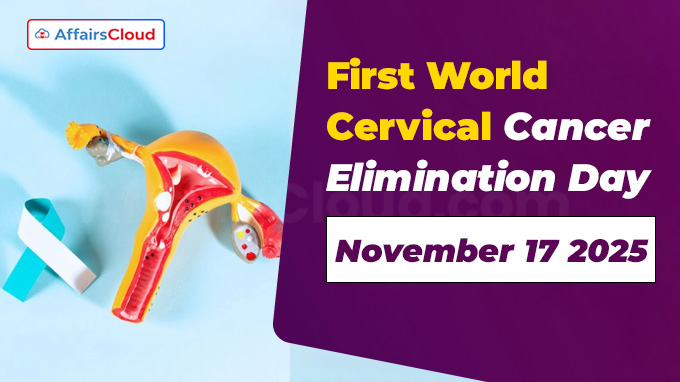The first-ever World Cervical Cancer Elimination Day (WCCED) was observed across the globe on 17th November 2025 to accelerate global efforts to eliminate cervical cancer as a public health problem.
- WCCED was organised by the World Health Organization (WHO).
- It stands out as the first official global health day dedicated to eliminating a specific cancer.
Theme :
Theme 2025: “Act Now: Eliminate Cervical Cancer”
Focus: The theme emphasizes urgent, collective action to prevent and ultimately eradicate cervical cancer worldwide.
Exam Hints:
- What? First-Ever World Cervical Cancer Elimination Day 2025
- When? 17 November 2025
- Theme 2025: “Act Now: Eliminate Cervical Cancer”
- Organiser: WHO
- Declaration: Adopted at the 78th World Health Assembly (WHA78.8) in 2025
- Significance: First official global health day dedicated to eliminating a specific cancer
- Goal: Promote HPV vaccination, cervical screening, and treatment to achieve elimination targets (90-70-90) by 2030.
Background:
Origin: In May 2018, the WHO Director-General(DG) Tedros Adhanom Ghebreyesus called for global action to eliminate cervical cancer, leading to the launch of the Cervical Cancer Elimination Initiative and the adoption of the Global Strategy in 2020.
Declaration: In May 2025, at the 78th World Health Assembly(WHA78.8), Member States adopted a resolution designating 17 November as World Cervical Cancer Elimination Day.
Establishment: Led by South Africa and Nigeria and co-sponsored by over 60 countries, the resolution institutionalizes the annual Cervical Cancer Elimination Day of Action to sustain global awareness and coordinated efforts.
About Cervical Cancer:
Definition: Cervical cancer is a malignant tumor that develops in the cells of the cervix, the lower part of the uterus that connects to the vagina.
Cause: Persistent infection with high-risk Human Papillomavirus (HPV) is the primary cause of cervical cancer.
Symptoms: Common signs include unusual vaginal bleeding, abnormal discharge, pelvic pain, pain during intercourse, and heavier or longer menstrual cycles.
Call to Action:
This year urges united and decisive efforts to accelerate progress toward the 90-70-90 targets by 2030, aiming for:
- 90% of girls vaccinated against HPV by age 15
- 70% of women screened with high-performance tests at 35 and 45
- 90% of women with cervical disease receive timely treatment.
Global Progress and Initiatives:
Vaccination: By the end of 2025, Gavi, the Vaccine Alliance, aims to reach 86 million girls, with countries like Rwanda, Nigeria, Bhutan, Pakistan, and India scaling up HPV vaccination for girls aged 9–14 years.
Screening: Countries are expanding cervical cancer screening, including innovations like self-sampling HPV tests, aiming for 70% of women to be screened with a high-performance test by ages 35 and 45.
UICC: The Union for International Cancer Control(UICC) supports global HPV vaccination and screening initiatives through advocacy, training, and funding.
About World Health Organization (WHO):
Director General (DG) – Tedros Adhanom Ghebreyesus
Headquarters – Geneva, Switzerland
Established – 1948





